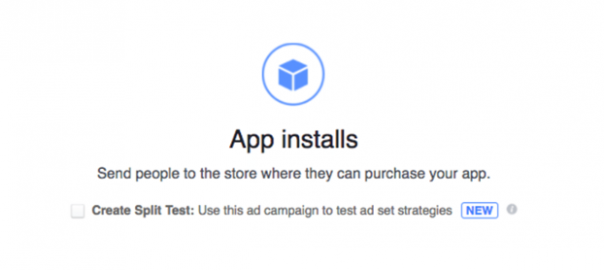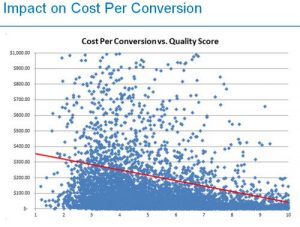— July 6, 2017
If you read our blog regularly, you’re probably used to hearing us say that the era of app acquisition being the most critical metric for app marketers is over. And that’s true! Successful mobile apps are all about user engagement. App acquisition is still important, of course, especially when you use it to develop new channels to engage with the customers you already connect with in-store or on email.
You can make a safe assumption that these users you’re connecting with are on social media, which has proven to be a solid user acquisition tool. For mobile audiences, marketers say it’s been the most effective way to acquire new users.
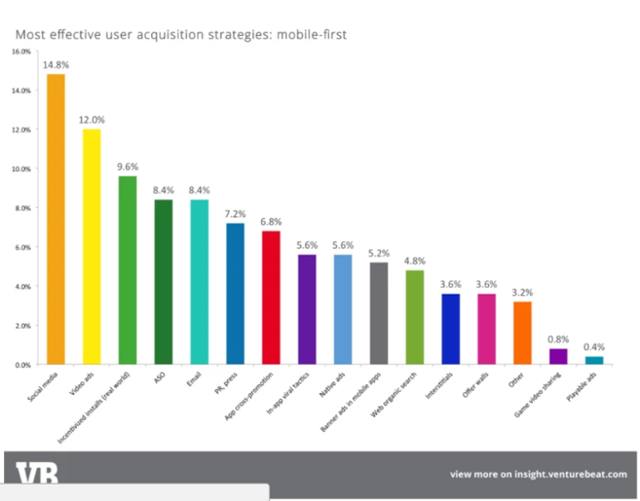
And Instagram is one of the most influential social networks out there, with over 700 million users worldwide. (Fun fact: it only took Instagram 4 months to go from 600 to 700 million users!)
With this kind of growth, Instagram represents a major opportunity for marketers to accomplish 2 significant goals:
Reach a new audience.
This group is who marketers traditionally tried to reach via social media ads. These were potential users who didn’t yet have a relationship with your brand.
Convince your current customers to engage with you on a different channel–your mobile app.
This group is even more important than the first for enterprise marketers. It’s long proven to be easier to engage and build stronger relationships with the customers you already have.
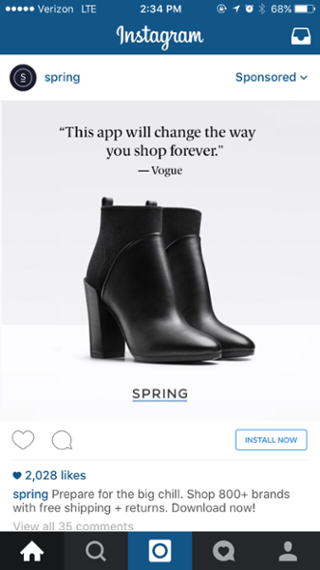
Spring knows I’m already a website user–and a great candidate to download their app.
That’s a foundational tenant behind omni-channel strategy; reaching your users on mobile is a major part of your omni-channel strategy. Don’t think of it as another device to market with–think of it as another way to connect with your customers and users. And the data’s in favor:
Brands that use omni-channel tactics in their marketing saw a 91% increase in year-over-year retention rates.
Connecting with your users on multiple channels, when and how they want, is a powerful way to increase customer/user retentions. The first step to doing so? Reaching them on the channels where you want to connect. Social networks like Facebook, Twitter, and Instagram each have over hundreds of millions of users.
What kind of apps should advertise on Instagram?
According to Facebook’s data, the topics seeing the most engagement on Instagram’s platform are fashion/beauty, food, TV/films, hobbies, and music. If your app is related to these areas, Instagram is the perfect way for you to reach new customers, and customers who haven’t yet downloaded your app. At the same time, 600 million users mean you shouldn’t count Instagram out if your app doesn’t fall in these areas.
But why Instagram over other types of ads?
1. Easy user path to download.
Instagram because as a mobile-only app, and mobile is still the means by which users primarily access the app. You can link your ad right to your listing on the App Store or Google Play, so your prospective app users have an easy path to downloading and trying out your app right away.
2. Creative flexibility.
Static images are a solid option, but you can use multiple images or even create an app preview video. For a powerful, functional app like Google Calendar, video is a huge opportunity to show off user benefits in a really compelling way.
3. Ads occupy the full mobile screen.
Unlike Facebook, Instagram ads fit directly into the user’s feed and take up the full screen of the device, like the other photos and videos that appear in their feed. It’s guaranteed that your audience will see your ad–if anything, if it’s too subtle, your user may not realize it’s an ad at all.

Here’s how HotelTonight’s app ad appeared in my Instagram feed. The beautiful photography would have made it fit perfectly into my feed, but the placement of the quote not only ads value, but helps clarify that it’s an ad–which, after all, helps ensure I won’t miss the point.
4. Segmentation.
Before you start developing your ad, make sure you have a good sense of your most valuable users. How old are they? Where are they located geographically? Do your users tend to be men or women? Facebook’s Instagram ad editor has hypertargeting capabilities, so you can ensure your ads are being seen by an audience that has a lot in common with your most valuable users. The Facebook/Instagram editor lets you target by demographic, interest, and behavior.
5. A/B testing capabilities.
Facebook’s Instagram ad editor lets you create A/B tests right in the platform. Regularly testing your ad creative brings ad optimization right into your ad strategy, and helps ensure you’re getting as much ROI as possible out of your ads.
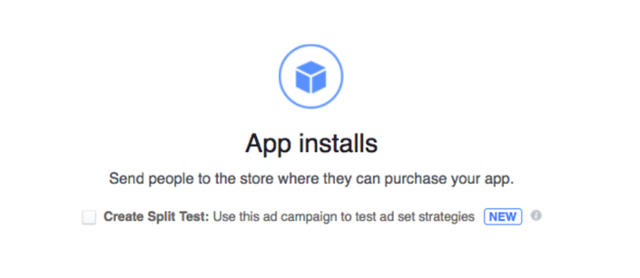
6. Facebook Integration.
Once you’ve put in the work to creating and testing your ads on Instagram, you can easily try them out on your Facebook audience, thanks to the aforementioned shared editor.
And finally, the the key metrics to consider after you’ve executed your campaign
App Installs. This is pretty straightforward. But be sure not to focus only on the raw number of app downloads. You might prefer to acquire smaller numbers of new users, if they’re more engaged and show higher retention rates than users who are quick to download, and quick to delete your app.
Engagement. Now that you know who was interested enough to download your app, how do these users compare to your other app users? How’s their engagement? More engaged users are likely to stick around longer and increase ROI over their lifetime.
Retention. Users don’t bring much value to your app if you can’t expect them to stick around very long. Track the retention rates of users acquired through instagram, and be sure to segment this group even further, with parameters like demographic.
Lifetime value. (LTV) LTV is the amount of revenue you can expect to receive from a user over the course of their lifetime. It’s closely tied to retention and cost of acquisition–once you’ve determined LTV, you can in turn determine the cost of acquisition per user. And obviously, the longer users stick around, the more revenue you can typically expect to see from them.
Cost of acquisition. Obviously, Instagram is a paid source. You’ll need to evaluate the cost of acquiring users this way, and whether it ultimately makes sense for your bottom line. Compare the costs of acquiring users through Instagram with your other channels to see how much value these users represent for your app.
Instagram’s a giant in the social networking world, and if you’re looking for the next step in your acquisition or omni-channel strategies, it could be perfect for you. Next up to consider? How to create the perfect Instagram ad.
Digital & Social Articles on Business 2 Community
(97)
